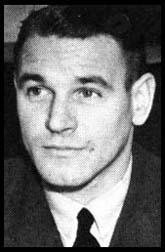Gysbert Malan

Gysbert Malan was born in Wellington, South Africa, on 3rd October, 1910. After leaving school he joined the ship General Botha as a cadet.
In 1924 Malan joined the Union Castle steamship as a junior deck officer. In 1935 he moved to England where he joined the Royal Air Force. Posted to 74 Squadron he soon showed he was a talented pilot and in 1939 was promoted to the rank of Flight Lieutenant.
Malan was involved in covering the evacuation at Dunkirk. During May, 1940, flying his Supermarine Spitfire, he shot down three enemy aircraft, damaged three and shared in the destruction of two more during the fighting over the Channel and northern France. As a result of this action he was awarded the Distinguished Flying Cross.
Malan also had considerable success during the Battle of Britain. Appointed commander of 74 Squadron on 8th August 1940 and by the end of the year had 18 confirmed kills.
Along with Douglas Bader Malan was selected to carry out what became known as the Big Wing strategy. Developed by William Sholto Douglas, the new head of Fighter Squadron, this strategy involved large formations of fighter aircraft deployed in mass sweeps against the Luftwaffe over the English Channel and northern Europe. This enabled Malan to add ten Messerschmitt Bf109to his score.
Malan now had 32 victories, placing him in third place behind Marmaduke Pattle (51) and Johnny Johnson (38). In July 1941, Malan was showing signs of combat fatigue and he was sent on a lecture tour of the United States. When he returned he was given command of the Central Gunnery School at Biggin Hill.
At the end of the war Malan held the rank of group captain. He retired from the RAF in 1946 and returned to the South Africa where he joined the staff of Oppenheimer's Diamond Training Company.
In 1950 Malan purchased a farm in South Africa. Upset by the election victory of the Nationalist Party he led a protest march of 8,000 ex-servicemen against the proposed apartheid system.
Gysbert Malan, who suffered from Parkinson's Disease in later life, died in South Africa on 17th September 1963.
Primary Sources
(1) Gysbert Malan's Ten of my Rules for Air Fighting appeared on many squadron notice boards during the Second World War.
1. Wait until you see the white of his eyes. Fire short bursts of one to two seconds, and only when your
sights are definitely 'on.'
2. Whilst shooting think of nothing else. Brace the whole of the body, have both hands on the stick, concentrate on your ring sight.
3. Always keep a sharp look-out. 'Keep your finger out.'
4. Height gives you the initiative.
5. Always turn and face the attack
6. Make your decisions promptly. It is better to act quickly even though your tactics are not of the best.
7. Never fly straight and level for more than thirty seconds in the combat area.
8. When diving to attack - always leave a proportion of your formation above to act as top guard.
9. Initiative, aggression, air discipline and team work are words that mean something in a air fighting.
10. Go in quickly - Punch hard - Get out!
